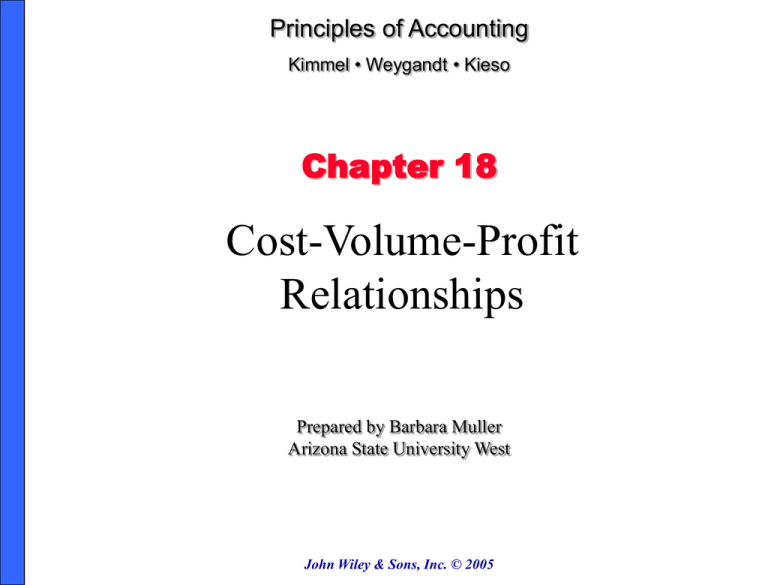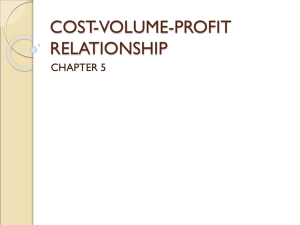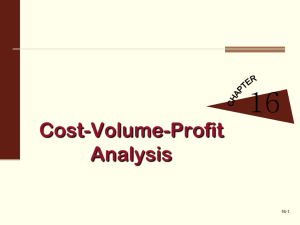
Principles of Accounting
Kimmel • Weygandt • Kieso
Chapter 18
Cost-Volume-Profit
Relationships
Prepared by Barbara Muller
Arizona State University West
John Wiley & Sons, Inc. © 2005
CHAPTER 18
COST-VOLUME-PROFIT RELATIONSHIPS
After studying this chapter, you should be able to:
Distinguish between variable and fixed costs.
Explain the significance of the relevant range.
Explain the concept of mixed costs.
List the five components of cost-volume-profit
analysis.
Indicate what contribution margin is and
how it can be expressed.
CHAPTER 18
COST-VOLUME-PROFIT RELATIONSHIPS
After studying this chapter, you should be able to:
Identify the three ways to determine the break-even
point.
Define margin of safety and give the formulas for
computing it.
Give the formulas for determining sales required to
earn target net income.
Describe the essential features of a cost-volume-profit
income statement.
COST BEHAVIOR ANALYSIS
Cost behavior analysis
• the study of how specific costs respond to changes in
the level of business activity
• begins with a measurement of key business activities
• these activities can be expressed in terms of
o
o
o
o
Sales dollars (retail company)
Miles driven (trucking company)
Room occupancy (hotel), or
Number of customers called on (salesperson)
The activity index identifies the activity
that causes changes in the behavior of costs
VARIABLE and FIXED COSTS
Study Objective 1
Variable costs
•Vary in total directly and proportionately with changes in the
activity level
•A variable cost remains the same per unit at every level of
activity
VARIABLE and FIXED COSTS
Fixed costs
•Remain the same in total regardless of changes in the
activity level
•Vary per unit inversely with activity
Let’s Review
Variable costs are costs that:
a. Vary in total directly and proportionately with
changes in the activity level.
b. Remain the same per unit at every activity
level.
c. Neither of the above.
d. Both (a) and (b) above.
Let’s Review
Variable costs are costs that:
a. Vary in total directly and proportionately with
changes in the activity level.
b. Remain the same per unit at every activity
level.
c. Neither of the above.
d. Both (a) and (b) above.
RELEVANT RANGE
Study Objective 2
Relevant range
•Range of activity over which the company expects to operate during a year
•Within this range, a straight-line relationship usually exists for both variable
and fixed costs
•Throughout the entire range of activity, this straight-line relationship usually
does not exist for variable and fixed costs
MIXED COSTS
Study Objective 3
Mixed costs (semivariable costs)
•Contain both variable and fixed cost elements
•Costs change, but not proportionately with changes in activity level
•Usually classified into their fixed and variable elements using the highlow method
HIGH-LOW METHOD
The high-low method uses total
costs incurred at the high and low
levels of activity
The high-low method produces a
reasonable estimate for analysis
purposes
HIGH-LOW METHOD
STEP 1
•Determine variable cost per unit using the following
formula:
Change in
Total Costs
÷
High minus Low
Activity Level
=
Variable Cost
per Unit
STEP 2
•Determine the fixed cost by subtracting the total variable cost at
either the high or the low activity level from the total cost at that
level
Components of CVP
ANALYSIS
Study Objective 4
Cost-volume-profit (CVP) analysis
•
•
•
is the study of the effects of changes of costs and
volume on a company’s profits
is a critical factor in management decisions
is important in profit planning
Assumptions of CVP Analysis
Assumptions underlying CVP analysis
• The behavior of both costs and revenues is linear
throughout the relevant range of the activity index
• All costs can be classified as either variable or fixed with
reasonable accuracy
• Changes in activity are the only factors that affect costs
• All units produced are sold
• When more than one type of product is sold, the sales
mix will remain constant
COMPONENTS OF CVP
ANALYSIS
CVP considers relationships among
the following components
Let’s Review
One of the following is not involved in
CVP analysis. That factor is:
a. Sales mix.
b. Unit selling prices.
c. Fixed costs per unit.
d. Volume or level of activity.
Let’s Review
One of the following is not involved in
CVP analysis. That factor is:
a. Sales mix.
b. Unit selling prices.
c. Fixed costs per unit.
d. Volume or level of activity.
CONTRIBUTION MARGIN
Study Objective 5
Since CVP is important for
management’s decision making process, a
CVP income statement is useful
Assists management by classifying costs as variable and fixed
Presents a contribution margin (amount of revenue remaining
after deducting variable costs)
Sales
–
Variable Costs
=
Contribution
Margin
CONTRIBUTION MARGIN PER
UNIT
Contribution margin is available to cover
fixed costs and to contribute to income
The formula for contribution margin per
unit is shown below
Unit Selling
Price
–
Unit Variable
Costs
=
Contribution
Margin per Unit
CONTRIBUTION MARGIN
RATIO
Contribution margin ratio shows the
percentage of each sales dollar available to
apply toward fixed costs and profits
Contribution
Margin per Unit
÷
Unit Selling
Price
=
Contribution
Margin Ratio
BREAK-EVEN ANALYSIS
Study Objective 6
The break-even point is the level of
activity at which total revenues equal
total costs – both fixed and variable
It can be
•
•
•
•
Computed from a mathematical equation
Computed by using contribution margin
Derived from a cost-volume-profit (CVP) graph
Expressed either in sales units or in sales dollars
FORMULA FOR BREAK-EVEN POINT IN
UNITS USING CONTRIBUTION MARGIN
At the break-even point, contribution margin
must equal total fixed costs (CM = total
revenues – variable costs)
• The break-even point can be computed using either
contribution margin per unit or contribution margin
ratio
• When the break even point in units is desired,
contribution margin per unit is used in the following
formula
Fixed Costs
÷
Contribution
Margin per Unit
=
Break-even
Point in Units
FORMULA FOR BREAK-EVEN POINT
IN DOLLARS USING
CONTRIBUTION MARGIN RATIO
When the break even point in dollars is desired,
contribution margin ratio is used in the
following formula
Fixed Costs
÷
Contribution
Margin Ratio
=
Break-even
Point in Dollars
GRAPHIC
PRESENTATION
A cost-volume-profit (CVP) graph shows
costs, volume, and profits
Used to visually find the break-even point
To construct a graph,
•Plot the total revenue line starting at the zero activity level
•Plot the total fixed cost by a horizontal line
•Plot the total cost line. This starts at the fixed cost line at zero activity
•Determine the break-even point from the intersection of the total cost
line and the total revenue line
CVP GRAPH
MARGIN OF SAFETY IN
DOLLARS
Study Objective 7
The margin of safety is the difference between
actual or expected sales and sales at the breakeven point
It may be expressed in dollars or as a ratio
The formula for determining the margin of safety
in dollars is shown below
Actual (Expected)
Sales
–
Break-even
Sales
=
Margin of Safety
in Dollars
MARGIN OF SAFETY
RATIO
The formula for determining the margin of
safety ratio is shown below
The higher the dollars or the percentage, the
greater the margin of safety
Margin of Safety
in Dollars
÷
Actual (Expected)
Sales
=
Margin of Safety
Ratio
TARGET NET INCOME
Study Objective 8
Target net income is the level of sales
necessary to achieve a specified income
The required sales may be expressed either in
sales dollars or sales units
The formula for required sales in dollars is as
follows
Fixed Costs +
Target Net Income
÷
Contribution
Margin Ratio
=
Required
Sales in
Dollars
FORMULA FOR REQUIRED SALES
IN UNITS
The formula for required sales in units is as
follows
Fixed Costs +
Target Net Income
÷
Contribution
Margin per Unit
=
Required
Sales in
Units
ESSENTIALS OF A COST-VOLUMEPROFIT INCOME STATEMENT
Study Objective 9
The CVP income statement classifies costs and
expenses as variable or fixed and specifically reports
contribution margin in the body of the statement
Traditional and CVP income statements based on
the data for the Vargo Video example in the text are
next shown side-by-side for comparative purposes
Net income is $120,000 in both statements
The major difference is the format for the expenses
TRADITIONAL VERSUS CVP
INCOME STATEMENT
VARGO VIDEO COMPANY
Income Statement
For the Month Ended June 30, 2005
CVP Format
Traditional Format
Sales
Cost of goods sold
Gross profit
Operating expenses
Selling expenses
Administrative expenses
Total operating expenses
Net income
$ 800,000
520,000
280,000
$ 100,000
60,000
160,000
$ 120,000
Sales
Variable expenses
Cost of goods sold
Selling expenses
Administrative expenses
Total variable expenses
Contribution margin
Fixed expenses
Cost of goods sold
Selling expenses
Administrative expenses
Total fixed expenses
Net income
$ 800,000
$ 400,000
60,000
20,000
480,000
320,000
120,000
40,000
40,000
200,000
$ 120,000
COPYRIGHT
Copyright © 2005 John Wiley & Sons, Inc. All rights reserved. Reproduction
or translation of this work beyond that permitted in Section 117 of the 1976
United States Copyright Act without the express written consent of the
copyright owner is unlawful. Request for further information should be
addressed to the Permissions Department, John Wiley & Sons, Inc. The
purchaser may make back-up copies for his/her own use only and not for
distribution or resale. The Publisher assumes no responsibility for errors,
omissions, or damages, caused by the use of these programs or from the use
of the information contained herein.









